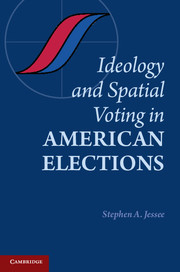Book contents
- Frontmatter
- Contents
- List of Figures
- List of Tables
- Preface
- 1 Introduction
- 2 Political Ideology
- 3 Measuring Political Ideology
- 4 Linking Theory and Empirics: Testing Spatial Voting Theory
- 5 Partisanship versus Proximity: The Effect of Party Identification on Spatial Voting
- 6 Political Information and Spatial Voting
- 7 The Political Perceptions of Citizens
- 8 Conclusion
- Appendix A Survey Question Wordings
- Appendix B Survey Sample Characteristics
- Appendix C Simplified Analyses of Ideology and Spatial Voting
- Appendix D American National Election Studies Analyses
- Bibliography
- Index
6 - Political Information and Spatial Voting
Published online by Cambridge University Press: 05 August 2012
- Frontmatter
- Contents
- List of Figures
- List of Tables
- Preface
- 1 Introduction
- 2 Political Ideology
- 3 Measuring Political Ideology
- 4 Linking Theory and Empirics: Testing Spatial Voting Theory
- 5 Partisanship versus Proximity: The Effect of Party Identification on Spatial Voting
- 6 Political Information and Spatial Voting
- 7 The Political Perceptions of Citizens
- 8 Conclusion
- Appendix A Survey Question Wordings
- Appendix B Survey Sample Characteristics
- Appendix C Simplified Analyses of Ideology and Spatial Voting
- Appendix D American National Election Studies Analyses
- Bibliography
- Index
Summary
Does it make sense, [that] two very different sorts of people – one extremely well informed and sophisticated about politics, the other not – make up their minds about how to vote in the same way?
(Sniderman, Brody, and Tetlock, “Reasoning and Choice,” 1991, 20)A key criticism of spatial voting theory, and also of the somewhat weaker theories of ideological or policy voting, is that it assumes a set of skills far beyond the capacities of most voters. According to this line of argument, the vast majority of citizens do not possess the information or conceptual capacities necessary to make decisions in this way. The preceding chapters have rebutted many key aspects of these criticisms: that most voters do not possess any sort of real ideological constraint, that voters cannot intelligently relate their own ideological positions to the actual locations of candidates in elections, and that partisanship exerts a predominant influence on vote choice, largely to the exclusion of other factors. What previous chapters have not done, however, is to assess the extent to which political information serves as a moderator of the effects of ideology and partisanship on vote choice.
- Type
- Chapter
- Information
- Ideology and Spatial Voting in American Elections , pp. 131 - 154Publisher: Cambridge University PressPrint publication year: 2012



